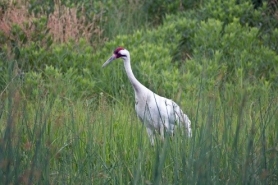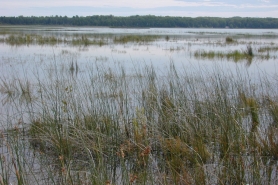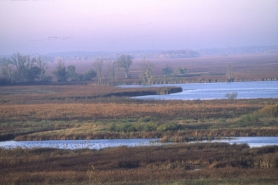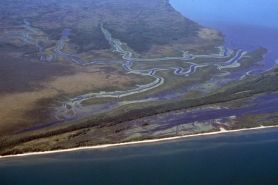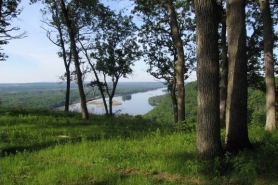Ramsar Wetlands
Ramsar Wetlands of International Importance in Wisconsin
Did you know that Wisconsin has wetlands that have been formally recognized as Wetlands of International Importance? The Wisconsin DNR is proud to be a landowner of many of these sites. Read on to learn more about Ramsar and the important wetlands in Wisconsin that have received this prestigious designation.
What is the Ramsar Convention?
The Ramsar Convention on Wetlands (The Ramsar Convention) is a non-regulatory, intergovernmental treaty that encourages wetland conservation in part by promoting the designation of Wetlands of International Importance (“Ramsar sites”) across the globe.
The U.S. has designated more than 40 sites within its borders as Wetlands of International Importance, including the Chesapeake Bay, the Everglades, and the Niagara River Corridor. Six of these sites are in the state of Wisconsin: Horicon Marsh, Upper Mississippi River Floodplain Wetlands, Kakagon/Bad River Sloughs, Door Peninsula Coastal Wetlands, Chiwaukee Illinois Beach Lake Plain and the Lower Wisconsin Riverway. Read on below for more information about each of these sites.
A few key facts about Ramsar site designation:
- Ramsar does not impose restrictions on nations and landowners.
- Site designation is voluntary.
- Site designation is entirely non-regulatory and does not supersede local ownership and management authority.
What about privately-owned land in these areas?
The only private land included in a Ramsar site is land whose owners specifically requested their land be included. Other individuals who own land within the area of a Ramsar Wetland of International Importance can ask that their land be added to the Ramsar site in the future, but no private land is automatically included.
What is special about Ramsar sites?
A site must meet at least one of nine criteria to qualify for designation:
- Host representative, rare or unique natural wetland types
- Harbor rare species and threatened ecological communities
- Provide habitat critical to biological diversity
- Provide support for plants or animals during critical life cycle stages or in adverse conditions
- Regularly support large numbers of waterbirds
- Regularly support at least 1% of a particular waterbird species
- Provide habitat for significant and representative fish
- Provide critical spawning grounds for fish
- Support to more than 1% of a non-avian population
What’s so great about wetlands?
Wetlands store water and slow its movement over our landscape. This helps reduce flooding, prevent erosion and soil loss, filter impurities, recharge groundwater and provide natural spaces for hunting, fishing, paddling and exploring. Wetlands also provide important fish & wildlife habitats.
How many Ramsar sites are there?
Wisconsin has six Ramsar sites: Horicon Marsh (1990), Upper Mississippi River Floodplain Wetlands (2010), Kakagon/Bad River Sloughs (2012), Door Peninsula Coastal Wetlands (2014), Chiwaukee Illinois Beach Lake Plain (2015) and Lower Wisconsin Riverway (2020). Learn more about these sites on the Wisconsin Wetlands Association webpage. According to the Ramsar Sites Information Service, as of April 2022, the United States has 41 Ramsar sites totaling more than 4.6 million acres.
Ramsar Wetlands of International Importance in Wisconsin:
| Chiwaukee Illinois Beach Lake Plain | This site is located on the south-western shore of Lake Michigan and features the highest quality coastal dune and swale ecosystem in southeast Wisconsin and northeast Illinois. It includes six globally rare and representative wetland types and rare wetland animals and plants. It also is among the largest blocks of stopover habitat for migratory birds along this part of Lake Michigan. The Wisconsin DNR is proud to be one of the landowners at this site. | |
| Door Peninsula Coastal Wetlands | This site occupies a major section of the Eastern Lake Michigan shoreline of northern Door County and comprises diverse examples of regionally and globally significant wetland communities, including interdunal wetlands and northern wet-mesic forest. It supports numerous species of fauna and flora and more than 150 species of birds that use the site for nesting or as staging areas during autumn and spring migrations. It also hosts rare animal species. The Wisconsin DNR is proud to be one of the landowners at this site. | |
| Horicon Marsh | This site is one of the largest intact freshwater wetlands in the United States and also one of the largest cattail marshes in the world. It is an important staging area for numerous species of migratory birds, especially Canadian geese and mallards. In the fall, 80% of the Mississippi Flyway population of Canada geese (around 1.1 million birds) and 2% of the regional population of mallards use this site during their migration. Other species, some of them endangered, use the area as a staging, nesting or feeding site. The Wisconsin DNR is proud to be one of the landowners at this site. | |
| Kakagon/Bad River Sloughs | This site is a largely undeveloped wetland complex composed of sloughs, bogs and coastal lagoons that harbor the largest natural wild rice bed on the Great Lakes. The area is under tribal management that is protected as a Conservation Area by an Integrated Resource Management Plan under the jurisdiction of the Bad River Band of the Lake Superior Tribe of Chippewa. It provides necessary and rare feeding, resting and nesting habitat for both migrating and local populations of birds. Tribal members frequent the area primarily for subsistence trapping, hunting, fishing and retaining historic harvesting techniques; access to the area is strictly limited to Bad River tribal members and Bad River Natural Resources staff. | |
| Lower Wisconsin Riverway | This site covers the longest free-flowing stretch of river in the Midwest and includes nearly 44,000 acres of land from the Prairie du Sac Dam to the confluence with the Mississippi River. Its importance is magnified through common boundaries with the nationally and internationally significant Mississippi River, the Driftless Area and the Upper Mississippi migratory bird flyway. The Riverway is one of Wisconsin’s most significant conservation and recreational areas because of its relatively wild, continuous natural area with a wide variety of native plant-animal communities. Its sloughs and marshes, forested bottomlands, sand terraces and bluff tops harbor many animal and plant species (some of them rare and threatened) and diverse and rich communities. The Wisconsin DNR is proud to be one of the landowners at this site. | |
| Upper Mississippi River Floodplain Wetlands | The natural floodplain backwaters of the Upper Mississippi River were enlarged and enhanced by the construction of locks and dams in the 1930s to improve commercial and recreational navigation. Today, the site consists primarily of flowing main and side channel habitats, large shallow to moderately deep backwater marshes, flooded floodplain forests and shrub-dominated communities. It is perhaps the most important corridor of fish and wildlife habitat remaining in the central U.S., supporting significant populations of more than 100 native fish species. In addition, the site is at the core of the Mississippi Flyway, through which 40% of North America's waterfowl migrate, including Canvasback Ducks and Tundra Swans. The Wisconsin DNR is proud to be one of the landowners at this site. |
For more information about Wisconsin’s Ramsar Wetlands of International Importance, visit the Ramsar page of the Wisconsin Wetlands Association’s website.


